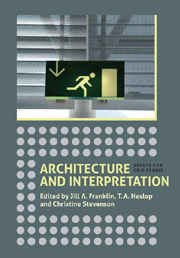Book contents
- Frontmatter
- Contents
- List of Illustrations
- Preface: In Appreciation
- List of contributors
- 1 Introduction
- Incitements to Interpret in Late Antique and Medieval Architecture
- Authors and Intentions
- 146 Home Sweet Mammoth: Neuroarchaeology and the Origins of Architecture
- 163 Constantine and Helena: The Roman in English Romanesque
- 176 For Their Monuments, Look about You: Medieval Masons and their Tombs
- 192 Baxandall's Bridge and Charles IV's Prague: An Exercise in Architectural Intention
- 221 Imitation as a Creative Vehicle in Michelangelo's Art and Architecture
- 242 The ‘Façade Problem’ in Roman Churches, c. 1540–1640
- Architecture beyond Building
- Index
176 - For Their Monuments, Look about You: Medieval Masons and their Tombs
from Authors and Intentions
Published online by Cambridge University Press: 05 April 2013
- Frontmatter
- Contents
- List of Illustrations
- Preface: In Appreciation
- List of contributors
- 1 Introduction
- Incitements to Interpret in Late Antique and Medieval Architecture
- Authors and Intentions
- 146 Home Sweet Mammoth: Neuroarchaeology and the Origins of Architecture
- 163 Constantine and Helena: The Roman in English Romanesque
- 176 For Their Monuments, Look about You: Medieval Masons and their Tombs
- 192 Baxandall's Bridge and Charles IV's Prague: An Exercise in Architectural Intention
- 221 Imitation as a Creative Vehicle in Michelangelo's Art and Architecture
- 242 The ‘Façade Problem’ in Roman Churches, c. 1540–1640
- Architecture beyond Building
- Index
Summary
IN A MODERN WORLD bombarded with information, how does the public acquire a view of the role and status of the architect? Given the deluge of news from the press, television and, of course, the Web, today it is almost impossible not to know about construction projects and their often ‘celebrity’ architects. A canny potential client will inspect a practice's previous and current projects, if possible in situ, while a visit to the office – its location, style, staffing – will provide an insight into professional business acumen and financial acuity. If the architect arrives at every meeting in yet another chauffer-driven Rolls-Royce, the client sees only success on wheels. Whether current stars of the architects’ firmament will be remembered five minutes after their demise is another matter. In the recent past, the more astute have commissioned their portrait in oil or print, while others inscribed their names somewhere on the main façade, a popular practice in late-Victorian and Edwardian times. Some have become eponymous with their work: Palladio's villas, the Gibbs building in Cambridge, the Eiffel Tower, numerous worldwide projects by Frank Lloyd Wright and almost anything remotely connected with Le Corbusier.
Were we to project ourselves back to the Middle Ages, how would we be able to judge the status of architects or ‘master masons’ in the society of their day? No architect that we know of was ennobled in the period, but then neither was any goldsmith, painter or sculptor. They all belonged to the ‘paid’ or ‘rewarded’ class of servants, not to the politically useful or financially ‘touchable’.
- Type
- Chapter
- Information
- Architecture and InterpretationEssays for Eric Fernie, pp. 176 - 191Publisher: Boydell & BrewerPrint publication year: 2012



